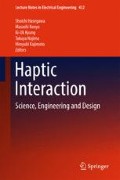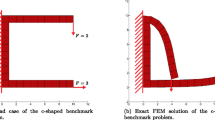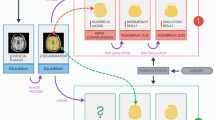Abstract
In this paper, we propose a rapid update approach of a global stiffness matrix for a binary online re-mesh and multi-rate finite element deformation simulation. Our approach enables us to generate realistic and stable reaction force and deformation with quick movement such as stick slip phenomenon. In early evaluative experiments, we can confirm that our approach contributes to the reduction of computational cost of deformation simulation.
Similar content being viewed by others
Keywords
1 Introduction
A computationally efficient deformation simulation algorithm for elastic objects contributes to the haptic interaction of surgical training systems, games and so on. However, because a high update rate (about 500 Hz) is required for stable haptic interaction, deformation simulation with high accuracy is especially difficult due to computational cost.
To reduce computational cost of deformation simulation, an online re-mesh method is proposed [1]. In the online re-mesh method, accuracy of deformation simulation is changed locally and dynamically according to the intensity of the strain. In addition, Debunne reported that a multi-rate method is also effective in deformation simulation [2]. In the multi-rate method, the time steps of each node is determined adaptively. We previously proposed a binary online re-mesh and multi-rate method [3]. In our proposed approach, an elastic object is represented by a multi-resolution hierarchy of tetrahedral adaptive mesh. In the binary online re-mesh and multi-rate method, first, accuracy of deformation simulation is changed as with the online re-mesh method. Secondary, the time step of each node is changed based on the new accuracy of deformation simulation. Figure 1 shows the tetrahedral adaptive mesh. However, because the approach with the binary online re-mesh and multi-rate method was not implicit integration, our previous approach has a problem with the stability.
2 A Fast Update Approach of a Stiffness Matrix for a Binary Online Re-Mesh and Multi-rate Finite Element Method
To solve above problem, we propose a fast update approach of stiffness matrix for finite element deformation simulation with the binary online re-mesh and multi-rate method on GPU. Figures 2 and 3 show examples of multi-rate deformation simulation of a cube model and ELL format [4] for the binary online re-mesh and multi-rate method where white lines show nonzero values of the sparse matrices. In our approach, a stiffness matrix is stored in ELL format. The advantage of selecting ELL format is that the number of columns of the ELL format is limited to 81 from feature of the tetrahedral adaptive mesh. Besides, local and fast update of a compressed global stiffness matrix is easy, for example, swapping rows. Each row of the stiffness matrix is sorted in ascending order of its time step \( \Delta t \). The time steps of each node are obtained by truncating its time step satisfying the Courant-Friedrichs-Lewy condition [5] to the nearest N-th power of two that N is natural number. In our approach, based on the time steps of each node, the size of simultaneous equations is varied in each cycle of deformation simulation.
3 Evaluation Experiment
As an early evaluative experiment, we compared computation time of a single-rate model, 0.134 (m) on a side of square, with a multi-rate model. The number of nodes and elements are 21 and 24, respectively. In the single-rate model, time steps of all nodes are determined to the minimum time step among all nodes. Biconjugate gradient stabilized method is used as a solver of FEM. In the simulation, the bottom right node was grasped and pulled. The simulation was performed on a PC (CPU: Intel Xeon(R) W3565 3.20 GHz), Memory: 16.0 GB, OS: Windows 10 Enterprise 64 bit, Compiler: Visual Studio 2010, SDK: Open Haptics 3.0).
Figure 4 and Table 1 show the simulation results and computation time. Through the experiment, we confirmed that our approach contributes to the reduction of computational cost of deformation simulation and the stability of deformation simulation.
References
Paloc, C., Faraci, A., Bello, F.: Online remeshing for soft tissue simulation in surgical training. IEEE Comput. Graphics Appl. 26, 24–34 (2006)
Debunne, G., Desbrun, M., Cani, M.P., et al.: Dynamic real-time deformations using space and time adaptive sampling. In: Proceedings of ACM SIGGRAPH’01, pp. 31–36 (2001)
Tagawa, K., Sasaki, Y., Tanaka, H.T.: Online re-mesh and multi-rate deformation simulation by GPU for haptic interaction with large scale elastic objects. In: Proceedings of IEEE Haptics, pp. 531–538 (2012)
Grimes, R., Kincaid, D., Young, D.: ITPACK 2.0 User’s guide. Technical Report CNA-150, Center for Numerical Analysis, University of Texas (1979)
Courant, R., Friedrichs, K., Lewy, H.: On the partial difference equations of mathematical physics. IBM J., 215–234 (1967)
Author information
Authors and Affiliations
Corresponding author
Editor information
Editors and Affiliations
Rights and permissions
Copyright information
© 2018 Springer Nature Singapore Pte Ltd.
About this paper
Cite this paper
Kuriki, R., Tagawa, K., Tanaka, H.T., Komori, M. (2018). A Fast Update Approach of a Stiffness Matrix for a Multi-rate Finite Element Deformation Simulation. In: Hasegawa, S., Konyo, M., Kyung, KU., Nojima, T., Kajimoto, H. (eds) Haptic Interaction. AsiaHaptics 2016. Lecture Notes in Electrical Engineering, vol 432. Springer, Singapore. https://doi.org/10.1007/978-981-10-4157-0_44
Download citation
DOI: https://doi.org/10.1007/978-981-10-4157-0_44
Published:
Publisher Name: Springer, Singapore
Print ISBN: 978-981-10-4156-3
Online ISBN: 978-981-10-4157-0
eBook Packages: EngineeringEngineering (R0)








